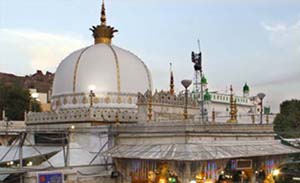Birth, Lineage and Early Life:
Khwaja Moinuddin Chishti (RA) was born in 530 AH ( 1136 AD) in Sanjar within the region of Sistan in modern-day Iran. Another source says he was born in Isfahan.
He was blessed with direct lineage to the Holy Prophet ﷺ through his father, Khwaja Ghiyasuddin Hasan (RA), who was a direct descendant of Hazrat Imam Hussein , son of Hazrat Ali and also through his mother, Umm-ul-Warah (RA) (alias Bibi Mah Noor), who was a descendant of Hazrat Imam Hasan another son of Hazrat Ali . Therefore Khwaja Moinuddin Chisti (RA) was both a Hasani (maternal) and Husseini (paternal) Syed.
His great grandfather, Khwaja Syed Ahmad Husain, migrated from Samarra in Iraq and eventually settled in Sanjar, within the region of Sistan.
His father was well-educated and a great Sufi of his time. At the time of birth of Khwaja Moinuddin Chishti (RA), Sistan and its surrounding lands were experiencing unprecedented political disturbances and plunder. Therefore his father decided to migrate to Khorasan which was a great hub of intellectual and economic activity and was home to learned Ulama and reputed Sufis. His father settled down in the Khorasan where he bought an orchard along with a windmill.
During his childhood Khwaja Moinudding Chisti( RA) showed early promise of a marvellous personality, displaying rare piety and sacrifice for others. He was brought up in Khorasan and received his early education at home. When he was nine years old, he committed the Holy Quran to memory. Subsequently, he was admitted to a Maktab, where he concentrated primarily on the hadis and fiqh (jurisprudence), and completed his education very early.
Khwaja Moinuddin Chisti (RA) was about fifteen years old when his father died in 544 AH. He was extremely heart-broken. Prior to his father’s death, the Tatar invaders had entered Khorasan and ransacked the province. He was overwhelmingly dismayed to see these scenes of terrible devastation.
One day, when he was watering his garden, between the months of Sha'aban and Zul-Hijjah in the year 544 AH/1150 AD, a mystic named Ibrahim Qandoozi (RA) unexpectedly entered. Khwaja Moinuddin Chisti (RA) extended to him the utmost courtesy and a hearty welcome, and offered him a bunch of grapes. The mystic was greatly pleased by the hospitality and the respect shown to him and wanted to repay Khwaja Moinuddin Chishhti (RA). He took out a piece of oil cake and upon chewing a portion of it, gave the rest to Khwaja Moinuddin Chishti (RA) to eat. As soon as he had eaten it, he underwent a strange transformation. He felt repugnance for mundane matters and sought to pursue the higher virtues and seek out the truth.
After the death of his father, he had inherited a grindstone and the orchard, which constituted his source of income. He sold his grindstone and the orchard and distributed the proceeds of these amongst the needy, the indigent, and the poor.
In those days, Baghdad, Samarkand, and Bukhara were celebrated centres of Islamic learning. From Khorasan he proceeded to Samarkand and then to Bukhara, where he pursued higher studies.He stayed there for about five years, from 544 AH/1150AD up to 550 AH/1155AD continuing his education up to the age of twenty. When Khwaja Moinuddin Chisti (RA) had acquired the best knowledge and wisdom of the time, he travelled widely in search of a spiritual guide who could provide him with the best spiritual guidance. He reached Iraq in 551 AH/1156 AD where he met the renowned saint Hazrat Sheikh Abdul Qadir Jilani (RA), better known as al-Ghawth al-A'zam, in Baghdad who after seeing him prophesized that he would become source of inspiration, centre of devotion and focus of affection of myriads of people. Subsequently he left Iraq and reached Haroon in Iran where he had the privilege of meeting the prominent sufi Hazrat Khwaja Usman Harooni (RA) who accepted him as his spiritual disciple. The spiritual guide and the disciple travelled far and wide for years. After he served his spiritual guide/teacher on tours and travels for about twenty years, Khwaja Usman Harooni (RA) appointed him as his sajjada nashin, his spiritual successor.
Khwaja Moinuddin Chisti (RA), after receiving the robe of caliphate from his spiritual guide and teacher, left on tours and travels again. He performed hajj and visited Medina where it is believed that in dream he received the Command of the Prophet Mohammad Holy ﷺ to proceed to Ajmer and spread there the Gospel of Truth. It is also believed that he was blessed by seeing the Holy Prophet Mohammad ﷺ in a dream who showed him the city, the fort, and the situation of Ajmer.
Khwaja Moinuddin Chishti (RA) reached Baghdad and moved on to Chisht on his way to Herat. From Herat, he proceeded to Sabzevar and reached Lahore via Multan. He then proceeded to Delhi and stopped on the way at Samana (now in the Patiala district), and from there, reached Ajmer for the first time at the age of around 52 years in 587AH/1191 AD on his divine mission. He had forty followers with him. His only armour for the success of his great mission was the greatest “invisible power” that pervades and sustains the whole universe. At that time, Ajmer was ruled by Prithvi Raj Chauhan the famous Rajput King. It is said that in Ajmer, he wanted to stay at the site where the Auliya mosque is now situated but servants of Prithvi Raj Chauhan did not allow him to do so on the pretext that the camels of Prithvi Raj Chauhan usually sat there. Khwaja Moinuddin Chishti (RA) thereupon stated to have countered: "If the camels sit there, let them sit." He then stayed on a Hill close to Ana Sagar lake and occupied the site now known as Chillah Khwaja Sahib. The camels returned to their usual place and sat there as usual, but once they sat, it is said that they were unable to stand up again. The Raja was informed. All the camel-drivers realized their mistake and tendered an unconditional apology. Khwaja Saheb, accepting the apology said: "Well, go. The camels now stand." When they returned, they saw the camels were standing. Khwaja Saheb stayed at a hill close to Ana Sagar lake. It is now known as the Chilla Khwaja Saheb. Soon the news of his piety,simplicity and affection for all spread far and wide, people began to flock to him in increasing numbers. Whosoever came to him, received the kindest treatment and blessings. People were so much inspired by his divine teaching and simplicity that they began to embrace Islam. Many became his disciples. Many later biographic account relate to numereous miracles ( KARAMAAT) wrought by Allah at the hands of the Great Khwaja during this period.
Khwaja Moinuddin Chishti (RA) continued his noble magnificent mission, showing the Path of Truth to the people. He has a number of followers and disciples. He also sent his disciples and successors to different parts of the country who also served the people and preached the tenets of Islam. A few of his prominent disciples are:
- Hazrat Khwaja Qutbuddin Bakhtiar Kaki (RA) (Delhi)
- Hazrat Sheikh Baba Fariduddin Ganjshakar (RA) (Pakpattan)
- Hazrat Sheikh Nizamuddin Auliya (RA) (Delhi)
- Hazrat Sheikh Nasiruddin Chiragh Dehlavi (RA) (Delhi)
When he had settled down in Ajmer, Khwaja Moinuddin Chishti (RA) married Bibi Ummat-ullah(RA) and they had three children.
- Khwaja Fakhruddin (RA)
- Khwaja Husamuddin (RA)
- Bibi Hafiza Jamal (RA)
His second marriage was with Bibi Asmat (RA), daughter of Syed Wajihuddin Mashhadi (ra) who was the commissioner of Ajmer in 620 AH/1223 AD. The marriage resulted in the birth of Hazrat Khwaja Ziauddin Abu Sa'id (RA).















.png)
